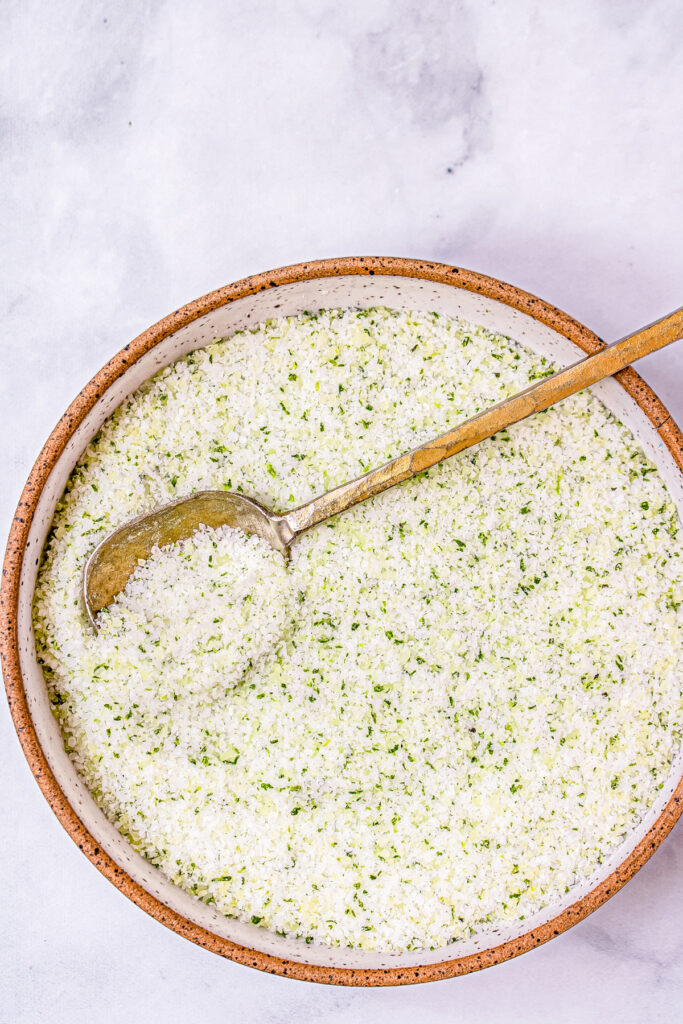Rosemary salt it seems like a gourmet spice that not everyone has available at home, but making it at home is very easy and it can take your recipes and dishes to the next level. Flavored salts are a great way to add an extra boost to recipes or finished dishes, and making rosemary salt or even any other flavored slat is easier and quicker than you think.
Flavored salts are available to buy, but making your own is so easy and quick that you’ll end up making not only rosemary salt, but other flavored salts recipes that we will be sharing here.
How to make Rosemary Salt
If you want to know how to make Rosemary Salt the best way, there are some things you need to have in mind. First, pick the right ingredients:
- Rosemary Leaves – Fresh or Dried
- Coarse Salt or Fine Sea Salt
Use fresh rosemary leaves, it will definitely give a stronger flavor than dried rosemary. If you use fresh rosemary from the beginning, you’ll get more flavor into the salt compared to using dried leaves.
Keep in mind that if you use fresh rosemary, you’ll need to spread the rosemary salt evenly on a baking sheet and leave out for at least 4 hours to dry. If you skip this step, the salt will stick together once you store it in a container. If you don’t have time to let it dry for 4 hours, you can speed up the drying process, baking the salt mixture at 200º F / 95º C for 20 minutes.
But, if you are in a rush and out of fresh rosemary, use dried rosemary leaves, and you’ll even get your rosemary salt quicker(since you can skip the drying process).

In this recipe you can use fine sea salt or coarse salt, it all depends on the dish you are going to prepare. Coarse salt, since it has bigger granules, is better for steaks and other dishes if adding a more salty impact is required. Use coarse salt if you are going to sprinkle your rosemary salt to add contrast to your dish. You’ll find that rosemary salt on top of a steak or a piece of bread adds delicious and salty contrast on the top of the surface. You can also use a mix of both type of salts to have a combination of big and small salt granules.
This rosemary salt is also a great gift for your family and friends! You’ll impress anyone with this simple and easy-to-make gift that your family and friends will love!
Rosemary salt, like any other flavored salt, has a lengthy shelf-life due to the nature of its ingredients, this is why it is good to make it ahead to have it ready to use in the future.
Rosemary Salt Recipe
Equipment
- Food Processor or Blender
- Oven (Only if you want to speed up the process)
Ingredients
- 1 cup salt (coarse or fine sea salt)
- 2-3 sprigs fresh rosemary (or dried)
Instructions
- Put the rosemary leaves and coarse salt(or sea salt or a mix of both) in a food processor.
- Pulse until the rosemary is completely blended into the salt, it will take about 7 to 10 times. Pulse until the texture should is similar to table salt. It will look like wet green sand.
- If you are using fresh rosemary, spread the mixture evenly over a baking sheet, cover with aluminum foil and leave it out to dry for a fat least 3-4 hours. If you need to speed up the process, you can bake for 20 minutes at 200º F / 95º C.
- Once the rosemary salt is dry, put it into a sealed airtight container and store it in a cool and dry place.
